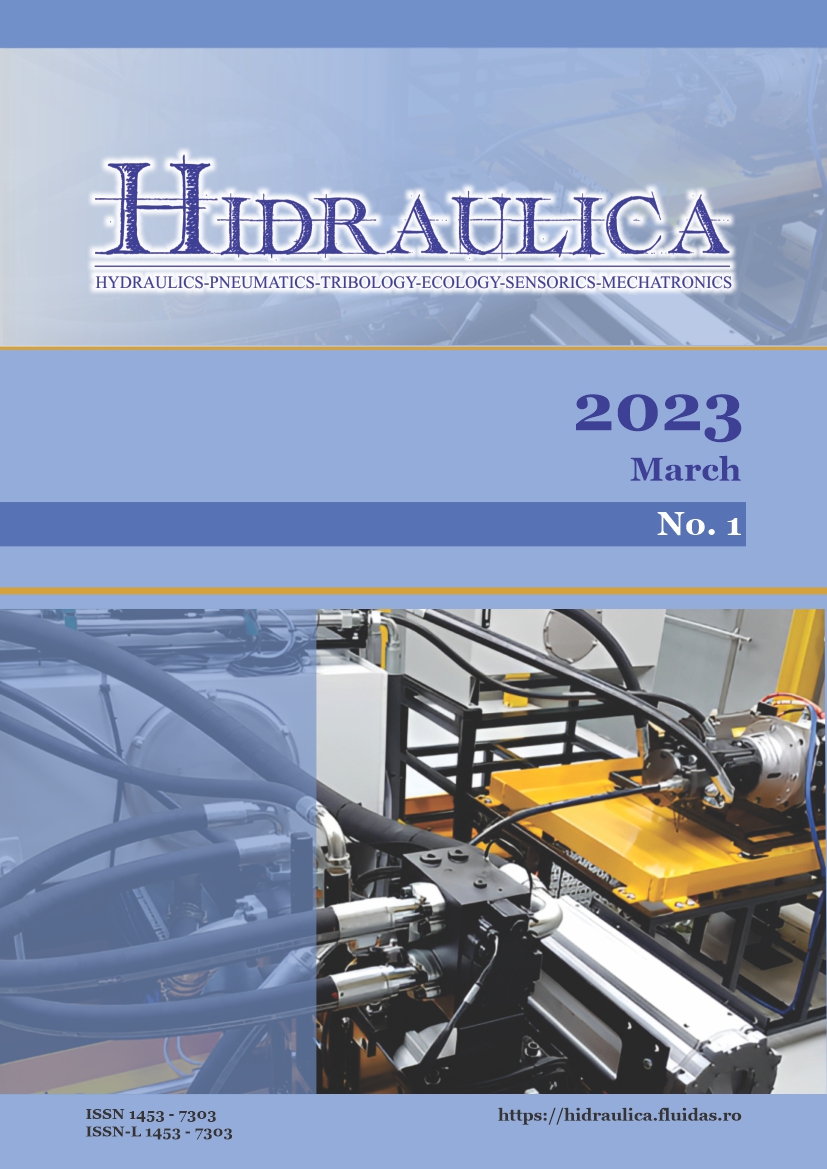Influence of Temperature Variations on the Operating Characteristics of the Hydro-Pneumatic Accumulators
Author: Anca BUCUREȘTEANU
In this paper, the authors present the mathematical models that can be used to determine the correlation between the variations of temperature and pressure in the industrial hydraulic units equipped with hydro-pneumatic accumulators. Two real cases of utilization of these systems are shown. First of all, the hydraulic units in which the oil volume in the accumulator circuit is negligible (as in the case of machine-tools and constructions equipment) are presented. The second case is the one of the units where the oil volume in the accumulator circuit is much higher than … (read more)
Research on the Behaviour of a Toroidal LPG Storage Tank under Uniaxial Traction Loads
Author: Petre OPRIŢOIU
A numerical model has been developed to reproduce the uniaxial traction loads on the three-dimensional (3-D) geometry of a hexagonal toroid with regular hexagonal cross-section used in the manufacturing of liquefied petroleum gas (LPG) storage tanks from the automotive industry. Several numerical applications are presented, with an optimization procedure, addressing the influence of affecting factors (temperature, corrosion and traction loads). Internal state stress and strains were also modeled using the finite-element method (FEM). The obtained results highlight the effectiveness of the proposed approach in correlating LPG) storage tank structure with external traction loads. The relationship between the strains, stresses, and the applied traction load noticeably deviates from … (read more)
Efficacy of Using the Loss Factor to Estimate the Power Requirements of Wind and Water Tunnels with Varying Cross Sections
Author: Alexander BARON VON HOHENHAU
Estimations of power requirements in wind tunnels are based on the assumption that pressure losses are proportional to the square of the flow velocity. This assumption is invalid for certain flow conditioners, particularly honeycombs and wire screens. Therefore, current methods of estimating power requirements across a range of flow velocities are, theoretically, prone to errors. This paper will review the existing approaches and show that … (read more)
Wind Action on Specific Building Structure Models of Reduced Height
Author: Fănel Dorel ȘCHEAUA
Wind action on building structures represents a real requirement on their resistance and there is a real concern on design made by the civil engineers building designers, especially when a multi-storey structure with a considerable height is considered for construction. Information provided in the design codes that specify the specific wind action values are used in the design activity. Analysis tools are also used based on the scale model of the structure being tested in the wind tunnel. The numerical analysis of air flow on the three-dimensional structure virtual model of a certain shape and size is a handy tool that can … (read more)
Computer Modelling of an Aquatic Fauna Complex Concrete Passage at a River Barrage
Authors: Albert Titus CONSTANTIN, Gheorghe I. LAZĂR, Cristian BRATANOVICI, Șerban-Vlad NICOARĂ
The paper presents a 2D computer structure modelling and discharge simulation for an improved aquatic fauna passage consisting on a three compartments stepped concrete channel and considered as a side appurtenant for a small head dam on a river upper course. The foreseen structure aims to reduce the barraging environmental impact by offering optimum flow conditions under given water discharging circumstances, meaning even for ensuring the minimum required sanitary/ecological river discharge as split by the main path through … (read more)
Energy Efficiency from Sustainable Materials
Authors: Elena SURDU, Dana-Claudia FARCAȘ-FLAMAROPOL
The environmental impact in the life cycle chain is significantly greater than that which occurs exclusively at the waste management stage. Recycling waste can help reduce greenhouse gas emissions and other emissions. Regarding the impact on the environment, sustainable constructions are those that meet certain criteria: the design, the management of the construction process and the performance materials used. From this perspective, the use of renewable energy resources and associated technologies in … (read more)
Laboratory Equipment for “Hot Air Generator with Forced Draft Fan Based on the TLUD Principle”
Authors: Ioan PAVEL, Gabriela MATACHE, Valentin BARBU, Ana-Maria POPESCU, Kati PAVEL
The issues related to the optimization of energy consumption in heating equipment have emerged in recent years, when research has been intensified for a more ecological, more modern and more efficient combustion achievable, for example, by addressing new combustion solutions or technologies, such as the use of the Top-Lit Updraft (TLUD) principle for heating equipment. The article presents a laboratory equipment piece for a “Hot air generator with forced draft fan based on the TLUD principle” that operates in the loop to maintain the temperature at 180°C at the chimney outlet, which is recommended for … (read more)
Sludge Dewatering Installations
Authors: Dana-Claudia FARCAȘ-FLAMAROPOL, Elena SURDU, Ramona MARE
In this article, we aimed to present the theoretical concepts, from the specialized literature, related to the dewatering of sludge resulting from the wastewater treatment process, focusing on the dewatering facilities used in our country and around the world. Emphasis is placed on mechanical dewatering, but also on … (read more)
